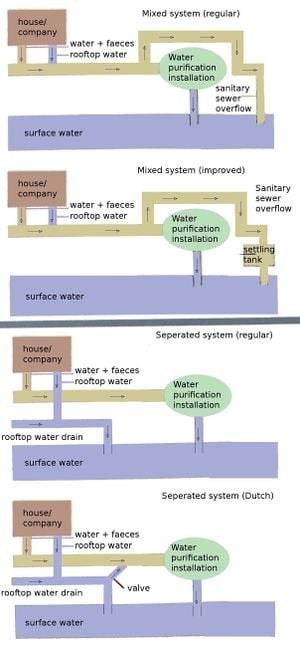
In on-site treatment, collection is simply a matter of directing the wastewater a short distance to the wastewater treatment unit. It is hereby important to treat blackwater separatly from greywater, as the latter is less polluted and so requires less treatment steps. By having less quantity of water going through less treatment steps the treatment procudure becomes more efficient and less costly.
In off-site treatment, collection is usually achieved by a network of pipes, known as sewers. Sewer systems were a major contributor to improved public health in the developed world in the late 19th and early 20th century (see London sewerage systemW).
Sewer design[edit | edit source]
An innovative low-cost method of sewerage in the Orangi Pilot ProjectW
- involves narrow piping, much more affordable than regular large diameter pipes.
- small chambers for collection of solids before the sewage enters the pipes. This allows the use of small diameter pipes without blocking.
This is less than ideal from a public health point of view, as the waste must be handled by collectors, and however careful they are some spillage is inevitable. However, as an appropriate technology it is a vast improvement over the previous situation of sewage in the streets, and was able to be paid for by the residents of a poor slum community.[verification needed]
Sewage disposal[edit | edit source]
Indonesian "septic tanks" (tengki septik?) are generally just concrete cylinders with open bottoms. This pollutes the groundwater supply, particularly in areas with high water tables (such as much of Surabaya). As groundwater is often used for domestic purposes, this is a problem. The polluted groundwater can also be sucked into the drinking water pipes (especially when wealthier users fit pumps to the outlets), so piped water is considered unsafe, although when it leaves the water treatment plant (e.g. in Surabaya) it is supposed to be drinkable.
It should be noted that there is a high level of awareness that water should be boiled before drinking. However I've also been warned not to buy drinks from vendors on an intercity train - Indonesian friends claimed that the sellers did not boil the water.
Contamination of water distribution systems[edit | edit source]
Most developed countries have a combined sewage/potable water system. However the potable water system gets polluted in certain cases.
In settings with piped water distribution, where demand for water exceeds the supply, the water pressure inside the pipes can become very low and flow becomes very low or even stops. The response of some people who can afford it is to fit a water pump to the outlet, to draw the water out. This further exacerbates the problem of low pressure in the pipes.
The low pressure means that groundwater is drawn into the pipes through leaks in the pipes. It is very common for a significant amount of a city's water supply to be lost to leaks (see non-revenue water on Wikipedia); however when the leaks flow in the other direction, it creates a serious water quality problem. the dropping below the pressure of the groundwater.[1]
It is claimed that HDPEW pipe greatly reduces water loss and contamination.[2]
See also[edit | edit source]
- Community-led total sanitation
- Composting toilets
- Wikipedia:Appropriate technology#Water and sanitation
See also[edit | edit source]
- Community-led total sanitation
- Composting toilets
- Wikipedia:Appropriate technology#Water and sanitation
External links[edit | edit source]
- ↑ Chriswaterguy has added this information based on his research in Surabaya, East Java, Indonesia, in 1996. See also:
- What causes water contamination? - from the Manila Water Company's FAQ.
- Of Low Water Pressure, Sucking Taps and Herbicide In Barbados - describes a scenario where low pressure could lead to serious toxins accidentally drawn into the water supply.
- ↑ Hdpe Potable Water Pipe Oxford Plastics Inc (commercial site).